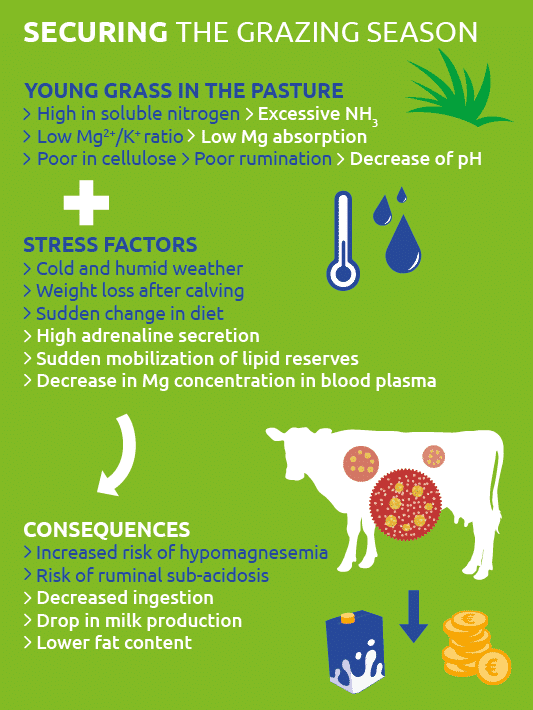
SECURING THE GRAZING PERIOD
OF DAIRY COWS
On pasture: beware of grass tetany
In the spring, young pasture grass is rich in soluble nitrogen and rapidly fermentable carbohydrates, poor in cellulose, and the ratio of magnesium to potassium (Mg2+:K+) is low. As a consequence, the intra-ruminal absorption of magnesium decreases. This is grass tetany, which presents a high-risk for dairy cows during their first two months of lactation.
Several stressors add up:
Low intake and low temperatures can trigger a large adrenaline release. This leads to a rapid lipolytic action with a sudden mobilization of lipid reserves, and a decrease in the concentration of magnesium in the blood plasma, causing grass tetany. This disease is characterized by neuromuscular and digestive disorders, accompanied by a decrease in intake and milk production. In the most severe cases, the animal may die.

3 things you may not know about grazing:
Magnesium level decreases because of stress factors
Indeed, above increase of Potassium level in the ration, influencing magnesium absorption, some stress factors at this period (temperature and humidity, ration change, loss of weight after calving) cause a quick mobilization of lipid reserves, which leads to magnesium trapped into adipocytes.
Sub-acidosis can also be developped during grazing
The change between winter ration and grazing can impact the rumen balance. Young grass is poor in cellulose and rich in highly fermentable energy, increasing acids production. Then it is important to prevent rumen imbalances and maintain an optimal rumen pH.
Magnesium contributes to production of fat content of the milk
It is common to observe a drop of fat content at grazing period, linked to the risk of acidosis or nutritional value of the grazed fodder.
Magnesium has a little known role, in stimulating the precursors passage necessary to the synthesis of the fat content from plasma to the udder.

OUR ADVICE
pHix-up ensures dairy cows are put out to grazing:
Only pHix-up combines a powerful, fast and persistent effect on rumen pH.
With a neutralization capacity 3 times higher than sodium bicarbonate (39 mEq/g) combined with a persistence of more than 96% after 6 hours*
pHix-up is a highly soluble source of magnesium
With a magnesium content of 48.5% and a solubility of between 86 and 97%**, pHix-up is an interesting source of magnesium for grazing.
*Publication 3R: Effect of buffer or alkalinizing solutions on ruminal pH in in vitro fermentation, A.Cohard et al.
** solubility in rumen juice on 10 trials in rumen juice.


– POWERFUL, FAST AND LASTING
action on rumen pH
– Source of HIGHLY SOLUBLE Mg for grazing period

Regulations for product are established by country. Please check the applicable claims on your area (cf label).
